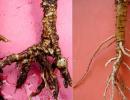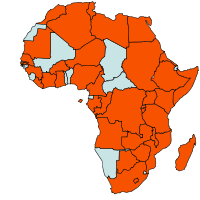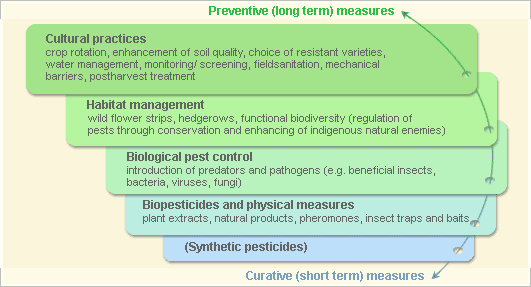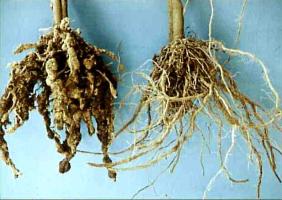
|
Root-knot nematodes
Scientific name:
Meloidogyne spp. (M. incognita, M. hapla, M. javanica, M. arenaria)
Order/Family:
Tylenchida: Meloidogynidae
Local names:
Eelworms
Type:
disease (nematodes)
Host plants: Bananas
Beans
Carrot
Citrus plants
Coffee
Cotton
Cowpea
Cucumber
Eggplant
Groundnut
Okra
Papaya
Passion fruit
Peas
Peppers
Pigeon pea
Pineapple
Potato
Rice
Soybean
Sweet potato
Tea
Tomato
Watermelon
Dolichos
|
| General Information on Pest and Damage | Cultural practices | |||
| Biology and Ecology of Root-knot Nematodes | Information Source Links | |||
| Pest and Disease Management |
General Information on Pest and Damage
Geographical distribution
 |
| Geographical Distribution of Root-knot nematodes in Africa (red marked) |
|
Introduction
The root knot nematode species, M. incognita, is the most widespread and probably the most serious plant parasitic nematode pest of tropical and subtropical regions throughout the world. It occurs as a pest on a very wide range of crops. Damage
Affected plants appear in patches. Estimates of vegetable crop losses due to Meloidogyne species, mainly M. incognita and M. javanica, have ranged from 17 to 20% for aubergine (Solanum melongena), 18 to 33% for melon and 24 to 38% for tomato. Losses of potatoes due to Meloidogyne species, mainly M. incognita, are estimated at 25% or more. Host range
Root-knot nematodes affect a wide range of crops, particularly vegetables. M. incognita is a major economic pest of food legumes in the tropics and subtropics. Common bean (Phaseolus vulgaris) is very badly damaged by Meloidogyne species in the tropics. Cowpea (Vigna unguiculata) is another very susceptible host crop of M. incognita. Many crops grown as vegetables are susceptible to the nematode particularly tomato, aubergine, okra, cucumber, melon, carrot, gourds, lettuce and peppers. Table I shows susceptibility of various commonly grown crops to root-knot nematodes.Table 1. Crop susceptibility to root-knot nematodes (after AfFOResT)
(Source: Dobson et al. 2002) |
Root-knot nematodes
|
Symptoms
Affected plants are stunted and yellow and have a tendency to wilt in hot weather. Very heavily infested plants are killed. Affected plants appear in patches. If infested plants are pulled from the soil, the roots are severely distorted, swollen and have lumps known as galls or root knots. The galls range in size from smaller than a pinhead to 25 mm or more in diameter.Affected plant stages
Flowering stage, fruiting stage, seedling stage and vegetative growing stage. Affected plant parts
Leaves, roots and whole plant. Symptoms on affected plant part
Leaves: wilting. Roots: galls; reduced root system; swollen roots.
Whole plant: dwarfing; wilting
Biology and Ecology of Root-knot Nematodes
Root-knot nematodes measure about 0.5 mm to 1.5 mm in length.
Juveniles (young nematodes) penetrate the root tips and occasionally invade roots in the zone of root elongation. Invaded nematodes initiate the development of giant cells in the root tissues and galling of roots occurs.
Root knot nematodes are soil inhabitants. They are spread by transplanting infested seedlings, or from soil washed down slopes or sticking to farm implements and farm workers. They may also be spread by irrigation water.
The disease is most serious on light, sandy soils and in furrow irrigated areas. Attack by nematodes may greatly increase the severity of bacterial, Fusarium and Verticillium wilt diseases
Conditions that favour development:
- Infected volunteer plants
- Monocultures
- Weeds in fields
- Warm temperatures and moist but well-aerated sandy soils
- Continuous growing of susceptible crops (no rotation)
Pest and Disease Management
Pest and disease management: General illustration of the concept of infonet-biovision

Further below you find concrete preventive and curative methods against Root-knot nematodes.
Cultural practices
Prevention and control
- Do not locate seedbeds where vegetables have been grown previously. After preparation of the seedbed, burn the topsoil using dry leaves or other waste plant material.
- Solarise seedbeds if possible.
- Use biofumigation where possible (for more information on biofumigation click here). Different mustards (e.g. Brassica juncea var. integrifoliaorBrassica juncea var. juncea) should be used as intercrop on infested fields. As soon as mustards are flowering they are mulched and incorporated into the soil. While incorporated plant parts are decomposing in a moist soil, nematicidal compounds of this decomposing process do kill nematodes. Two weeks after incorporating plant material into the soil a new crop can be planted or sown.
- Maintain high levels of organic matter (manure and compost) in the soil.
- Incorporate neem cake powder into the soil if it is available.
- Fields should be ploughed deep and the followed by a dry fallow.
- Uproot entire plants from the field after harvest and destroy crop debris.
Crop rotation
Rotate with onions, baby corn, sweet corn, maize, millet, sorghum, sesame, cassava or Sudan grass.A rotation system called "STRong" is recommended for management of root-knot nematodes. The system was developed by, African Farmers' Organic Research and Training (AfFOResT), a NGO in Zimbabwe. It involves planting in rotation of a susceptible crop (e.g. tomatoes), followed by a tolerant crop (e.g. cabbage) and then a resistant crop (e.g. onions) before a return to a susceptible crop (e.g. tomatoes). Crop susceptibility of various commonly crops is given in Table 1.
Use trap crops such as marigold (Tagetes spp.) and Indian mustard. (A trap crop is a crop planted to attract a pest and is then destroyed together with the pest). Mixed cropping with marigold can also minimise root-knot nematode damage.
Resistant varieties
Use resistant tomato varieties (e.g. 'Caracas', 'Kentom', 'Meru', 'Piersol', 'Roma VFN', 'Tengeru 97', 'Zest F1', 'Star 9001', 'Star 9003'). Tomato varieties carrying 'VFN' label are tolerant to root-knot nematodes. Most of these varieties are commercially available in the region. Information Source Links
- Additional information about nematodes: Genome Sequencing Center: www.nematode.net
- Beije C.M, Kanyagia S.T., Muriuki S.J.N., Otieno E.A., Seif A.A. and Whittle A.M. (1984). Horticultural Crops Protection Handbook. National Horticultural Research Station.
- Crop Protection Compendium, 2005 Edition. © CAB International, Wallingford, UK, 2005 www.cabi.org
- Dobson, H., Cooper, J., Manyangarirwa, W., Karuma, J., Chiimba, W. (2002). Integrated Vegetable Pest Management. Natural Resources Institute, University of Greenwich, UK. ISBN: 0-85954-536-9
- OISAT. Organisation for Non-Chemical Pest Management in the Tropics www.oisat.org
- Varela, A.M., Seif, A.A., and Löhr, B. (2003). A Guide to IPM in Tomato Production in Eastern and Southern Africa. ICIPE, Nairobi, Kenya. ISBN: 92 9064 149 5
- Varela, A.M.and Seif, A. (2004). A Guide to IPM and Hygiene Standards in Okra Production in Kenya. ICIPE, Nairobi, Kenya. www.icipe.org

 Back
Back

